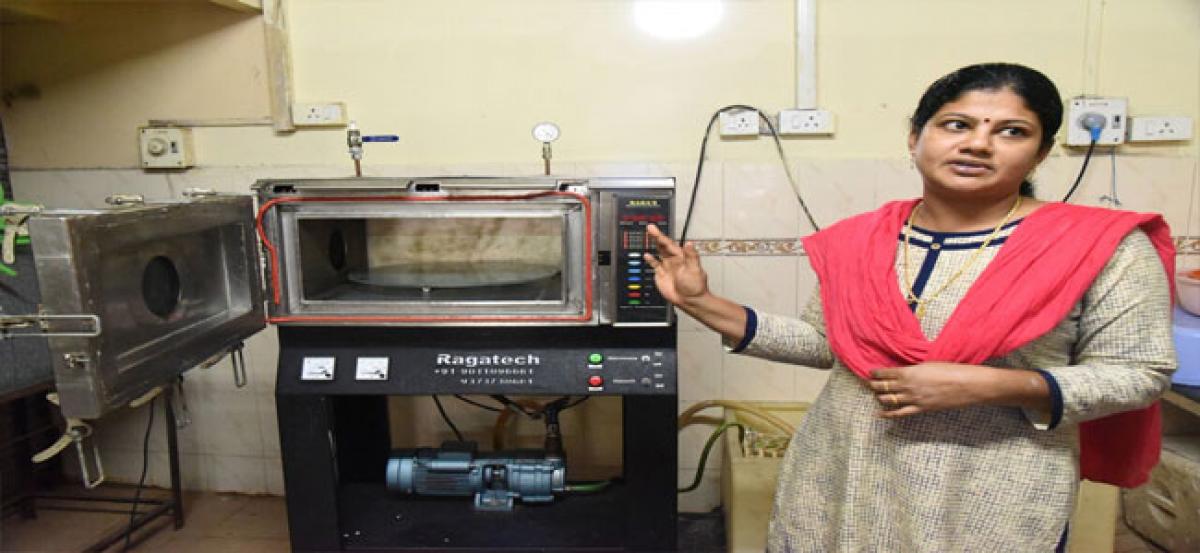Live
- G20 Leaders Will Talk About Climate, Taxes, and Trump's Return in Brazil
- COP29: CDRI announces $8 million funding for 12 projects to address climate crisis
- Anti-Telgu remarks: Actor Kasthuri Shankar moves court for bail
- Samsung AR Smart Glasses Set to Launch in 2025, Featuring Ray-Ban Meta-Like Design
- Kerala Industries Minister confident that new policy will boost plantation sector
- Madras HC plans inter-departmental monitoring committee to combat drug use in TN
- Bihar: Spotted deer dies due to heart attack in Banka district
- Mushtaq Ali T20: Shami to spearhead Bengal bowling attack, Gharami named captain
- Kharge's clarion call to oust Maharashtra's BJP-backed MahaYuti
- Why Ukraine’s Use of US Missiles Against Russia Could Lead to World War 3
Just In

Microwave vacuum drying is an emerging technology for drying heat sensitive products. High product quality can be achieved by low temperature and the rapid energy transfer of microwave heating,’’ Dr Viji said. She said the combination of vacuum and microwave has the potential to reduce drying time, improve product quality and decrease energy consumption. It was never tried in the past.
Visakhapatnam: Central Institute of Fisheries Technology developed an innovative project- microwave vacuum oven, first of its kind in the country, for drying fish that will ensure a super quality of the product, have longer shelf life and suitable for exploring export markets.
Highlights:
- The new technology ensures a super quality of fish with longer shelf life and suitable for exploring export markets
- Dr Viji says the combination of vacuum and microwave has the potential to reduce drying time, improve product quality and decrease energy consumption
Dried fish represents the cheapest source of concentrated protein for people living in hinterlands, hilly areas or in places where there are no water bodies. As per the age-old tradition, the fisher folk dry fish openly under sun which ultimately gives a product of low hygienic quality because of the uncontrolled process which includes intervention by birds and stray animals.
Over the years, scientists have been cracking their brains to upgrade the process so that more can be produced under controlled conditions that will have subscribers.Several methods of mechanical drying have been developed, including hot air oven drying, combination of solar energy and mechanical drying, smoke drying, freeze drying and vacuum drying.
“Microwave vacuum drying is an emerging technology for drying heat sensitive products. High product quality can be achieved by low temperature and the rapid energy transfer of microwave heating,’’ Dr Viji said. She said the combination of vacuum and microwave has the potential to reduce drying time, improve product quality and decrease energy consumption.
It was never tried in the past.
Dr P Viji said preliminary trails have demonstrated that microwave vacuum drying can retain the original colour, improve the sensory attributes while reducing the time required for bringing down the moisture content to 30 per cent.
Fish has 80 per cent moisture. While the time required for open sun drying vary from one to two days, mechanical drying from 12 to 15 hours, the microwave vacuum drying takes just one to two hours. The temperature is maintained at 55 degrees so that the fish is not cooked during the process of drying, said senior scientist Dr B Madhusudhana Rao.
Senior scientist in-charge of CIFT Dr Raghu Prakash, who supervised the project, said there is a huge potential if the fish dried in large quantity and standardised on par with the export quality.
They can be exported to foreign countries and sold in the super markets within the country. Around 10 million of tonnes of fish land in the country of which only 10 per cent is exported and of this less than a lakh tonne dried fish is exported to countries like Bangladesh and Sri Lanka. The exports were 70,554 tonnes in 2014-2015 and came down to 43,320 tonnes in 2015-2016. Around two lakh tonnes are sold within the country.
“Usually, discarded fish is sent for drying but under this new project, good quality fish can be dried, packed and sold in the markets. Some people relish dry fish rather than fresh,’’ Dr Prakash said.
By KMP Patnaik

© 2024 Hyderabad Media House Limited/The Hans India. All rights reserved. Powered by hocalwire.com







